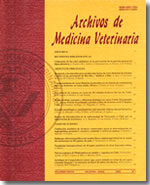Seasonal reproductive activity of Pelibuey ewes under arid conditions of México
Main Article Content
Abstract
Twenty-two multiparous Pelibuey ewes managed under intensive conditions were exposed to rams and used for blood sample collection during one year, to evaluate the effect of season of the year on estrous cycle characteristics, ovulation and corpus luteum functionality under arid conditions in Mexico (32° NL). Rams were daily introduced with ewes to identify estrous behavior, while blood samples were individually collected twice per week to determine ovulation through progesterone concentrations. Additionally, blood samples were individually collected every three days during an overall estrous cycle to determine corpus luteum functionality. Estrous cycles and estrous signs in each ewe were classified based on their duration in normal, short, large, and multiple. Ewes maintained a steady live weight (P > 0.05) and body condition score (P > 0.05) across all seasons. The number of total and normal estrous cycles, as well as the number of total and normal estrous signs per ewe was greater (P < 0.05) in summer and autumn than in winter and spring. Compared with winter and spring, higher (P < 0.05) number of ovulations per ewe and lower (P < 0.05) percentage of ewes with silent estrous were observed in summer and autumn. Progesterone concentrations between days 5 and 14 of the estrous cycle were higher (P < 0.05) in autumn than in winter and spring. In conclusion, under arid conditions of Mexico located at 32o NL, Pelibuey ewes reduce their estral and ovulatory activity, as well as the corpus luteum functionality in winter and spring seasons.

